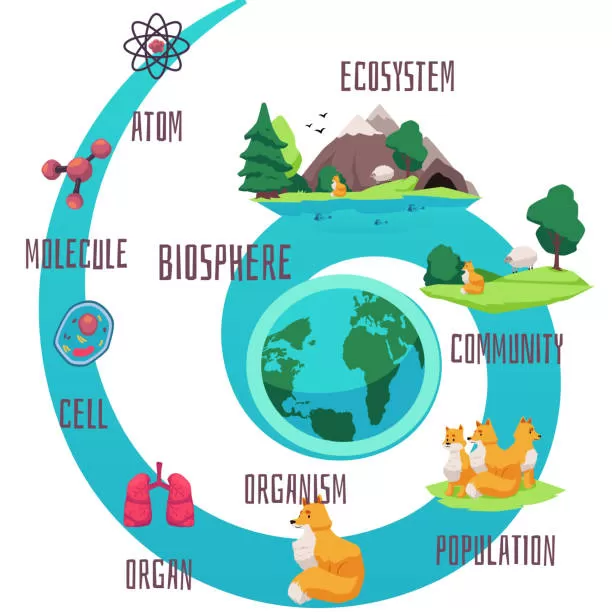Naming and Explaining The Largest Biological System on Planet Earth: The largest biological system on Earth is the biosphere, which is defined as the total sum of all living organisms and their interactions with each other and with their physical environment.
The biosphere is the single largest ecosystem of the earth. The biosphere is known as the sum of all ecosystems also known as the ecosystem also the zone of life on earth
The biosphere encompasses all living things on Earth, including plants, animals, and microorganisms, as well as the non-living components of the environment that they rely on, such as air, water, and soil.

Here are seven easy-to-understand facts about why the biosphere is considered the largest biological system on Earth:
- Encompasses All Life: The biosphere includes every living organism on Earth, from the tiniest bacteria to the largest whales, making it the most extensive biological system.
- Global Reach: It extends from the deepest ocean floors to high up in the atmosphere, covering diverse habitats like forests, deserts, and coral reefs.
- Interconnected Ecosystems: The biosphere is made up of countless interconnected ecosystems, each with its unique organisms and environmental conditions.
- Life Support System: It acts as a life support system for the planet, regulating and maintaining the conditions necessary for life, like oxygen production and climate control.
- Biogeochemical Cycles: The biosphere drives vital biogeochemical cycles, like the carbon and nitrogen cycles, crucial for sustaining life on Earth.
- Biodiversity Hotspot: It’s home to an incredible variety of life forms, known as biodiversity, which is essential for ecosystem health and resilience.
- Human Dependence: Humans rely on the biosphere for everything from food and medicine to air and water purification, highlighting its importance as the largest biological system.
Each of these points underscores the vastness, complexity, and crucial role of the biosphere in sustaining life on our planet.
The biosphere can be divided into a number of different levels, each of which has its own unique characteristics and interactions. The smallest level is the individual organism, which is made up of cells, tissues, and organs. These individual organisms interact with one another to form populations, which in turn interact with other populations to form communities. Communities of different organisms, along with their physical environment, make up ecosystems. Ecosystems can be grouped into biomes, which are regions characterized by their climate, geology, and dominant plant and animal life. The sum of all of these biomes, along with the oceans, atmosphere, and geosphere, make up the biosphere as a whole.
The biosphere is a complex and dynamic system that is constantly changing and adapting. The different levels of the biosphere are interconnected, and changes at one level can have ripple effects throughout the entire system. For example, changes in the population of one species can affect the populations of other species that depend on it for food or shelter. Similarly, changes in the physical environment, such as changes in temperature or precipitation, can affect the distribution and survival of different species.
The biosphere also plays a critical role in regulating the Earth’s climate and maintaining the planet’s overall health. For example, the process of photosynthesis, which occurs in plants, is responsible for producing the oxygen that makes life on Earth possible. Additionally, plants and other organisms act as carbon sinks, absorbing and storing carbon dioxide from the atmosphere, which helps to regulate the Earth’s temperature.
Despite its vast scale, the biosphere is also incredibly fragile and vulnerable to human activities. The destruction of natural habitats, pollution, overfishing, and climate change are all taking a toll on the biosphere and its ability to support life. The loss of biodiversity is one of the most pressing issues facing the biosphere today, as the extinction of even a single species can have a ripple effect throughout the entire system.
The biosphere is a reminder of the interconnectedness of all living things and the importance of protecting and preserving the planet’s natural resources. It also serves as a reminder of the critical role that human beings play in shaping the future of the Earth. By understanding the biosphere and the impact that we have on it, we can make more informed decisions about how we use the planet’s resources and how we can work to protect and preserve it for future generations.
In conclusion, the biosphere is the largest biological system on Earth, it is defined as the total sum of all living organisms and their interactions with each other and with their physical environment. It encompasses all living things on Earth, including plants, animals, and microorganisms, as well as the non-living components of the environment that they rely on. The biosphere is a complex and dynamic system that is constantly changing and adapting, it plays a critical role in regulating the Earth’s climate and maintaining the planet’s overall health. However, it is also incredibly fragile and vulnerable to human activities, it is important for human beings to understand the biosphere and the impact that we have on it, to make more informed decisions about how we use the planet’s resources and how we can work to protect and preserve it for future generations.
